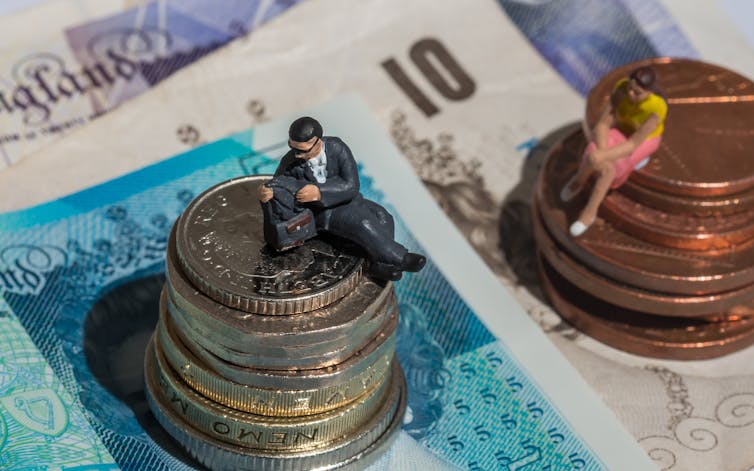
It will take 217 years for women to achieve equal pay, at the current rate, according to the World Economic Forum. So we can expect many more stories of women earning far less than their male peers – such as the recent case of Carrie Gracie at the BBC, who recently resigned over a pay gap of around 50% between her and men doing similar work. There has been limited improvement in closing the gender pay gap since the passing of the Equal Pay Act 1970.
While comparing men and women doing similar work is how people normally think of equal pay, there is also the principle of being paid the same amount for making an equal contribution to an organisation – even if doing a different job within it. The first groundbreaking case to recognise this was Julie Hayward v Cammell Laird in 1988. A tribunal recognised that Julie Hayward, a cook working for Cammell Laird, should be paid the same as her male counterparts working in the shipyard, as her role required a similar level of skills and training.
These developments were necessary – but inadequate to challenge unequal pay across industries. The latest statistics reveal that women, on average, earn 9.1% less than men. You might think this seems like progress – but it hides what is really happening in specific sectors. For instance, finance employs over a million people and the gender pay gap in that sector is closer to 40%.
This may seem surprising, but what most people hear about are the cases affecting high-profile women such as Carrie Gracie. The much more difficult issue is in the realm of low-paid work. For example, when the national minimum wage was first introduced, more than 60% of those who benefited were women.
Unrecognized and undervalued
Women are generally caught between a rock and a hard place. For many, their skills are unrecognized or systematically undervalued and they are usually corralled into a few areas of underpaid work: caring, cleaning, catering and retail. They also find themselves at the bottom of pay scales.
Most people discussing the causes of unequal pay focus on the occupational segregation and ignore the question of valuing women for what they already do. For example, “soft” skills (such as interpersonal or caring skills) are identified with women, rather than the hard-edged business and finance skills identified with highly paid men. This allows employers and free market enthusiasts to claim that it is all women’s own fault because they don’t apply for the better-paid jobs. It ignores the barriers women face.
My own research points to power relations in the workplace as central to why it is so difficult to crack the equal pay problem. Historically, men entered most industries earlier than women and were able to dominate key positions, excluding women from skilled work. Employers were only too happy to gain the resulting benefit of women’s cheap labour. Little has changed.
In my former industry, printing, the nature of the work – despite much technological development – has not overturned the basic definition of different jobs as skilled, semi-skilled or unskilled. Because men gained early access to the best positions as employers and workers, they were able to dominate the interpretation of skill, ensuring women became trapped in occupations defined as “low skilled”. Discrimination keeps them there.
Discrimination gets trivialized
The claim that inequality exists because women don’t apply for better jobs is an example of an important process at play called delegitimisation. This is where the claims women make for issues that particularly affect them and their claims of discrimination are trivialised. It similarly affects the credibility of the women themselves as they try to progress their careers.
Equality issues are also delegitimised by employers as something that only the law can address. Yet, despite the appearance of a lot of equality legislation, closer examination shows it up to be so flawed that it rarely makes much real difference. More often, employers identify an individual woman as having a problem, failing to recognise the group-based nature of discrimination. We need to be aware that women rarely suffer discrimination because of their individual characteristics but simply because they are women. Focusing on the individual can make it appear that action is being taken – which it might be for their specific circumstance – while really nothing much changes for the group.
Those who have the relative power to change things are primarily employers, but also male workers seeking to defend their relative privilege and pay. After all, pay and hierarchical position are important in defending men’s status and self-esteem.
Nevertheless, unions have moved towards tackling these inequalities more than most – and this should provide some hope. If the government were to reverse its long-running hostility towards trade unions, given that unions have supported most of the significant equal pay cases, this would probably have the added benefit of reducing pay inequality more generally.
Improving the law through class actions would allow women to join their legal claims together, making it more likely that women would have the confidence to bring cases. A law preventing companies from levelling the playing field by bringing down the pay of those that earn more, as happened in printing in the late 1980s and early 1990s, would give the law much more purchase – and men could feel more confident that their own pay would not suffer. Plus, collective agreements negotiated by trade unions have much greater impact because they cover whole groups of workers.
![]() With a rejuvenated Labour Party more sympathetic to these changes, we might yet see that 217-year wait for equal pay whittled down to something much more acceptable.
With a rejuvenated Labour Party more sympathetic to these changes, we might yet see that 217-year wait for equal pay whittled down to something much more acceptable.
Tricia Dawson, Lecturer in Human Resource Management, Keele University


Leave a Reply